Solid Geometry Chapter 3 Theorems On Areas
Chapter 3 Theorems On Areas Comparison of areas of two or more two parallelograms:
- You have already learned that a parallelogram is a plane area of quadrilateral in shape in which the opposite sides are parallel.
- The base of this parallelogram is that side of it upon which the parallelogram stands by.
- There are four sides to a parallelogram.
- So, any one of these four sides can be considered as the base of the parallelogram if it lies stand-by on this side and if the side is horizontal in position.
- For example, AB is the base of the parallelogram ABCD, SR is the base of PQRS, etc.
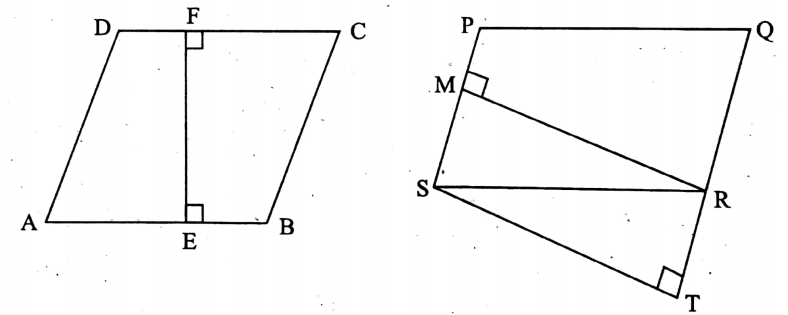
- The height of any parallelogram is the perpendicular distance of any two parallel opposite sides.
- EF is the height of the parallelogram ABCD.
- ST or RM is that of PQRS.
Read and Learn More WBBSE Solutions For Class 9 Maths
Pair of parallel straight lines:
By the term pair of parallel st. lines, we usually denote two straight lines which are parallel to each other.
Such as in the following figure, AB and CD are a pair of parallel st. lines.

Area of a parallelogram :
By the area of a parallelogram, we generally mean the measurement of the plane area closed by the four sides of this parallelogram.
Area of a parallelogram = Base x Height of the parallelogram.
Such as the area of ABCD = AB × EF, where AB = base and EF = Height of the parallelogram ABCD.
Heights of the parallelograms between the same pair of parallel straight lines.
Since the perpendicular distance between any two points of two parallels at any point always remains the same, the heights of the parallelograms lying in between these two parallels will also be the same or will be equal in magnitude.
For example, the heights of the parallelograms ABCD, EFGH, LMNO, etc. between the pair of parallels PQ and RS are all equal. Because,

height of ABCD=XY; of EFGH = UV, of LMNO TW, and XY = UV=TW.
Notice that the bases of the parallelograms are not the same, or their lengths are not also equal, i.e., DC ≠ HG ≠ ON.
Now, if the bases of them be the same, or the length of the bases is equal, then we get,
![]() ABCD = DCXXY;
ABCD = DCXXY;
![]() EFGH = HG x UV = DC x XY [∵ HG = DC]
EFGH = HG x UV = DC x XY [∵ HG = DC]
![]() LMNO = ON x TW = DC x XY [∵ ON DC]
LMNO = ON x TW = DC x XY [∵ ON DC]
![]() ABCD =
ABCD = ![]() EFGH =
EFGH = ![]() LMNO
LMNO
Therefore, (1) Area of a parallelogram = Base x Height.
(2) The areas of the parallelograms having the same base or equal length of heights and lying in between two parallels are equal.
We shall now prove the above theorems geometrically.
Theorem 1. Parallelograms on the same base and between the same parallels are equal in area.
Given: Parallelograms ABCD and PQRS have the same base BC and between the same parallels BC
and AQ.

To prove Area of ABCD = Area of PBCQ.
Proof: In ABCD, AB || DC and AQ are their transversal,
∴ ∠BAP similar CDQ………(1)
Again, in PBCQ, PB || QC, and AQ are their transversal,
∴ ∠CQD= similar ∠BPA ……..(2)
∴ in AABP and ADCQ, ∠BAP = CDQ [by (1)], BPA = < CQD [by (2)]
and AB = DC [∵ opposite sides of ![]() ABCD]
ABCD]
∴ Δ ABP = Δ DCQ [by the condition of A-A-S congruence].
∴ ΔABP ≅ Δ DCQ
or, Δ ABP + ![]() PBCD = Δ DCQ +
PBCD = Δ DCQ + ![]() PBCQ. [ adding
PBCQ. [ adding ![]() PBCD on both sides. ]
PBCD on both sides. ]
Or, ![]() ABCD =
ABCD = ![]() PBCD
PBCD
∴ Area of ABCD = Area of PBCQ (Proved)
Corollary-1: Area of parallelogram = Base x Height.
Given: ABCD is a parallelogram, the base of which is BC and the height of which is h.
To prove: Area of ![]() ABCD = Base x Height = BC x h.
ABCD = Base x Height = BC x h.
Construction: Let us draw the rectangle PBCQ, taking BC as the base and in between the same parallels. BC and AD, which intersects DA at Q and extended DA at P.
Proof: Parallelogram ABCD and rectangle PBCQ have the same base BC and lie in between the same parallels BC and PD.
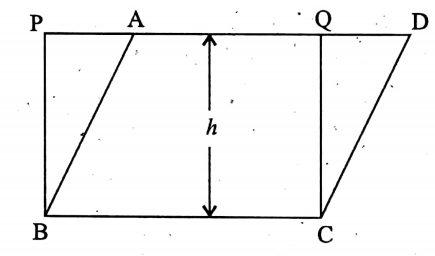
∴ Area of the ![]() ABCD = Area of the
ABCD = Area of the ![]() PBCQ
PBCQ
= Length x Breadth
= BC x CQ=BC x h [ ∵ CQ = h]
= Base x Height.
∴ Area of a parallelogram = Base x Height (Proved)
Corollary-2: Parallelograms having equal lengths of bases (not the same) and which lie in between the same parallels are equal in areas.
Given: The base AB of ![]() ABCD and the base PQ of
ABCD and the base PQ of ![]() PQRS are equal in length and they lie between the same parallels EF and GH.
PQRS are equal in length and they lie between the same parallels EF and GH.
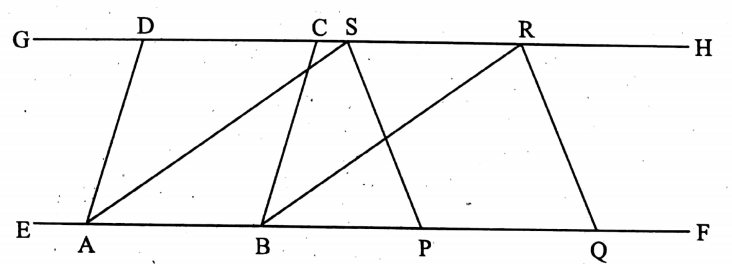
To prove Area of ![]() ABCD = Area of
ABCD = Area of ![]() PQRS.
PQRS.
Construction: Let us join A, S and B, R.
Proof: In the quadrilateral ABRS, AB || SR [ ∵ EF || GH]
and AB = SR [∵ AB = PQ and PQ = SR, ∴ AB = SR]
∴ ABRS is a parallelogram [∵ two of its opposite sides are equal and parallel. ]
Now, ![]() ABCD and
ABCD and ![]() ABRS have the same base AB and they lie between the same parallels EF and
ABRS have the same base AB and they lie between the same parallels EF and
∴ Area of ![]() ABCD = Area of
ABCD = Area of ![]() ABRS ……………(1)
ABRS ……………(1)
Again, ![]() RSAB and
RSAB and ![]() RSPQ has the same base RS and they lie in between the same parallels GH and EF.
RSPQ has the same base RS and they lie in between the same parallels GH and EF.
∴ Area of ![]() RSAB = Area of
RSAB = Area of ![]() PQRS ………….. .(2)
PQRS ………….. .(2)
From (1) and (2) we get,
Area of ![]() ABCD = Area of
ABCD = Area of ![]() PQRS. (Proved)
PQRS. (Proved)
Chapter 3 Theorems On Areas Comparison Between The Areas Of A Triangle And Of A Parallelogram
You know that area of a triangle = \(\frac{1}{2}\) base x height.
Thus, if the base and height of a triangle and of a parallelogram be the same, i.e., if they have the same base and lie between the same parallels, then the area of the
triangle = \(\frac{1}{2}\) x (base x height) = \(\frac{1}{2}\) x (area of the parallelogram)
∵ area of the parallelogram = Base x Height.
∴ The area of the triangle having the same base is half of the parallelogram with the same base.
We shall now prove this theorem logically by the method of geometry.
Theorem 1. If a parallelogram and a triangle are on the same base and between the same parallels, then the area of the triangle is half the area of the parallelogram.
Given: ΔABC and ABDE are on the same base AB and between the same parallels AB and CD [ for figure no. (1)] or, AB and ED [ for no. (2)]
To prove : ΔABC = \(\frac{1}{2}\) ![]() ABDE.
ABDE.

Construction: Let us draw AF through A, parallel to BC which intersects extended DC at F
[for the (1)] or, extended DE at F [ for the (2) ].
Proof: In the quadrilateral ABCF, AB || FC (Given) and BC || AF [by construction]
∴ ABCF is a parallelogram.
Now, ![]() ABCF and
ABCF and ![]() ABDE are on the same base and between the same parallels AB and FD.
ABDE are on the same base and between the same parallels AB and FD.
area of ![]() ABCF = area of
ABCF = area of ![]() ABDE.
ABDE.
Again, AC is a diagonal of ![]() ABCF.
ABCF.
∴ ΔABC = \(\frac{1}{2}\) ABCF. [∵ The diagonal of a parallelogram bisects it in equal areas.]
∴ ΔABC = \(\frac{1}{2}\) ABDE [ ∵ ![]() ABCF =
ABCF = ![]() ABDE]
ABDE]
∴ ΔABC = \(\frac{1}{2}\) ABDE. (Proved)
Corollary-3: Area of a triangle = \(\frac{1}{2}\) Base x Height.
Given: The base of the ΔABC = BC and AP 1 BC, Height of the ΔABC = AP.
To prove : ΔABC = \(\frac{1}{2}\) BC x AP.
Construction: Let us draw such a rectangle BCDE on the base BC that E, A, and D are collinear.
Proof: BCDE is a rectangle,
∴ BC || ED, i.e., BC and ED are a pair of parallel straight lines.
Now, ΔABC and ![]() BCDE is on the same base BC and between the same parallels BC and ED.
BCDE is on the same base BC and between the same parallels BC and ED.
∴ ΔABC = \(\frac{1}{2}\) ![]() BCDE [∵ rectangle is a special type of parallelogram]
BCDE [∵ rectangle is a special type of parallelogram]
= \(\frac{1}{2}\) × BC x BE [∵ area of a rectangle = length > breadth]
= \(\frac{1}{2}\) x BC x AP [ ∵ AEBP is a parallelogram, ∴ two opposite sides BE and AP are equal.]
∴ Δ ABC = \(\frac{1}{2}\) BC x AP. (Proved)
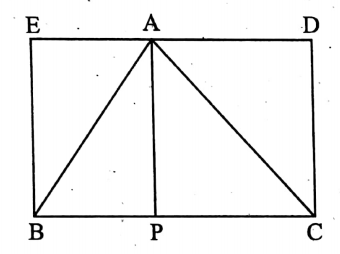
Chapter 3 Theorems On Areas Comparison Between Areas Of Two Or More Triangles
We have seen the heights of all the triangles between the same parallels if their bases lie on any one of the two parallel lines.
Therefore, if the bases of them be the same (or of equal lengths), then the areas of the triangles are equal.
We shall now prove this theorem logically.
Theorem 1. Two triangles on the same base (or equal bases) and between the same parallels are equal in area.
Given: ΔABC and ΔABD are on the same base AB and lie between the same parallels AB and DC.
To prove : ΔABC = ΔABD.
Construction: Let us draw such a parallelogram ABPQ on the base AB that it lies between the same parallels AB and DC.
Proof: ΔABC and ![]() ABPQ are on the same base AB and between the same parallels AB and PQ.
ABPQ are on the same base AB and between the same parallels AB and PQ.
ΔABC = \(\frac{1}{2}\) ![]() ABPQ……………..(1)
ABPQ……………..(1)
Again ΔABD and ![]() ABPQ are on the same AB and between the same parallels AB and PQ.
ABPQ are on the same AB and between the same parallels AB and PQ.
∴ ΔABD = \(\frac{1}{2}\) ABPQ………….…(2) [ by theorem-24]
Now, from (1) and (2) we get, ΔABC = ΔABD. (Proved)
∴ ΔABD = \(\frac{1}{2}\) ABPQ………….…(2) [ by theorem-24]
Now, from (1) and (2) we get, ΔABC =ΔABD. (Proved)
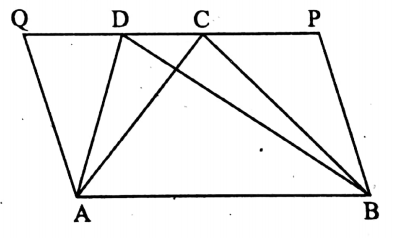
Corollary-4: The areas of the triangles having bases of equal lengths and equal heights are equal.
Given: BC is the base of the ΔABC and AP ⊥ BC,
∴ AP is the height of the ΔABC.
Again, EF is the base of the ADEF and DQ ⊥ EF,
∴ DQ is the height of the Δ DEF.
By the given condition, BC = EF and AP = DQ
To prove: Δ ABC = Δ DEF
Proof: Δ ABC = \(\frac{1}{2}\) base x height
= \(\frac{1}{2}\) x BC x AP [by the corollary-3]
= \(\frac{1}{2}\) × EF x DQ [∵ BC = EF and AP = DQ]
= Δ DEF [∵ Δ DEF = \(\frac{1}{2}\) x base x height =\(\frac{1}{2}\) EF × DQ]
∴ Δ ABC = Δ DEF. (Proved)
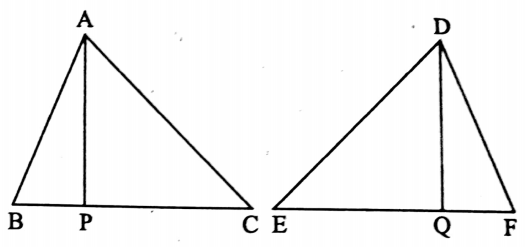
Corollary-5: The median of any triangle bisects it into two triangles of equal areas.
Given: The median AD bisects the ΔABC into two triangles ΔABD and ΔACD.
To prove ΔABD = ΔACD.
Construction: Let us draw AE ⊥ BC.
Proof: AD is the median of ΔABC,
∴ BD = CD…….. (1)
Again, AE ⊥ BC,
∴ AE is the height of both the ΔABD and ΔACD.
Now Δ ABD = \(\frac{1}{2]\) × BD x AE [by corollary-3]
= \(\frac{1}{2]\) x CD x AE [ ∵ BD = CD by (1)]
= Δ ACDE [ ∵ Δ ACD = \(\frac{1}{2}\) x CD x AE, cor.-3]
∴ Δ ABD = Δ ACD. (Proved)
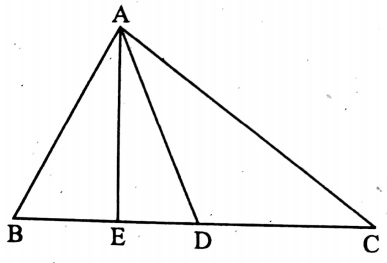
Corollary-6: Area of a Trapezium = \(\frac{1}{2}\) (sum of the parallel st. lines) x height= \(\frac{1}{2}\) × (sum of F A the parallel st. lines) x (Perpendicular distance of them).
Given: In the trapezium ABCD, AB || DC and BE ⊥ DC,
∴ BE is the height of the trapezium ABCD
or, BE is the perpendicular distance of the parallel st. lines.
To prove: Area of the trapezium ABCD = \(\frac{1}{2}\) x (AB + DC) × BE.
Construction: Let us draw a perpendicular DF from D to the extended BA, which intersects it at F and join B and D.
Proof: DF is the perpendicular from D to the extended base BA,
∴ DF is the height of the AABD.
Again, AB || DC (Given) or BF || DC.
∴ FD= BE [∵ both are the perpendicular distances between AB and DC. ]
Now, area of the trapezium ABCD = Area of ΔABDC+ area of ΔABD.
= \(\frac{1}{2}\) x DC x BE + \(\frac{1}{2}\) × AB × FD
= \(\frac{1}{2}\) x DC x BE + AB x BE [∵ FD = BE]
= \(\frac{1}{2}\) × BE x (DC + AB)
= \(\frac{1}{2}\) x (AB + DC) × BE. (Proved)
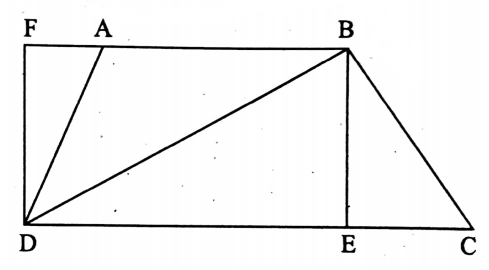
Theorem 2. Two triangles having the same base (or equal bases) and on the same side of the base and of equal areas lie between the same parallels.
Given: The areas of the ΔABC and ΔACD are equal and they are on the same base AC and on the same sides of AC.
Let us join B, D.
To prove AC || BD.
Construction: Let us draw two perpendiculars BP and DQ from B and D respectively to AC which intersects AC and extended AC at P and Q respectively.
Proof : Δ ABC = \(\frac{1}{2}\) x AC x BP……..(1) [∵ AC = base and BP = height]
ΔACD = \(\frac{1}{2}\) x AC x DQ…………….(2) [∵ AC base and DQ = height]
Δ ABC = Δ ACD (Given), from (1) and (2) we get,
\(\frac{1}{2}\) x AC x BP = \(\frac{1}{2}\) × AC x DQ
or, BP = DQ.
Again, BP ⊥ AC and DQ ⊥ (extended AC).
∴ BP || DQ
Thus, in the quadrilateral BPQD, BP = DQ and BP || DQ.
BPQD is a parallelogram.
PQ || BD ( opposite sides of a parallelogram)
or, AC || BD ( PQ and AC are the same st. lines).
∴ AC || BD. (Proved)
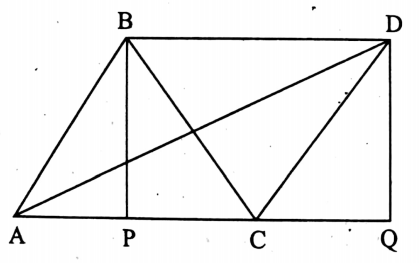
Chapter 3 Theorems On Areas Applications Of The Above Theorems On Real Geometrical Problems
In real geometrical measurements, we have to use the above theorems-1, 2, 3, and 4.
In the following examples, the applications of these theorems are discussed thoroughly.
Chapter 3 Theorems On Areas Select The Correct Answer (MCQ)
Question 1. D, E, and F are the mid-points of the sides of BC, CA, and AB of the ΔABC. If ΔABC= 16 Sq.cm., then the area of the trapezium FBCE is-
- 40 sq. cm
- 8 sq. cm
- 12 sq. cm
- 100 sq. cm
Solution:
Given
D, E, and F are the mid-points of the sides of BC, CA, and AB of the ΔABC.
ΔABC= 16 Sq.cm.
∵D and F are the mid-points of BC and AB respectively,
∴ DF || CA
or, DF || EA…………..(1) Similarly, DE || FA………….(2)
From (1) and (2) we get, AFDE is a parallelogram of which FE is a diagonal,
Δ AEF = Δ DEF [∵ diagonal of a parallelogram divides it into two congruent triangles.]
Similarly, it can be proved thatΔ BDF = Δ DEF = Δ CDE
i.e., Δ AEF = Δ BDF = Δ DEF = Δ CDE……………..(3)
Now, trapezium FBCE = Δ BDF + Δ DEF + Δ CDE
= Δ BDF + Δ BDF + Δ BDF [by (3)] = 3Δ BDF
= 3 × \(\frac{1}{4}\) x 4 Δ BDF = \(\frac{3}{4}\) Δ ABC [∵ 4 Δ BDF = Δ ABC]
= \(\frac{3}{4}\) x 16 Sq. cm,
[∵ ΔABC= 16 Sq. cm. ]
= 12 sq. cm.
∴ 3. 12 sq. cm is correct.
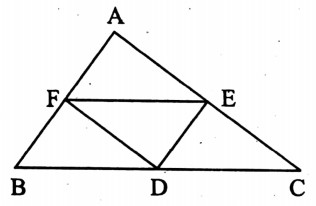
Alternative Method:
F and E are the mid-points of AB and AC,
∴ FE || BC
Let us draw AQ T BC, which intersects FE at P.
FE || BC, AP ⊥ FE and AP = PQ
Also, PQ is the height of the trapezium FBCE.
area of the trapezium FBCE = \(\frac{1}{2}\) x (BC + FE) x PQ
= \(\frac{1}{2}\) x (BC + \(\frac{1}{2}\) BC) x \(\frac{1}{2}\)
[∵ FE = \(\frac{1}{2}\) BC, PQ = \(\frac{1}{2}\) AQ]
= \(\frac{1}{2}\) x \(\frac{3}{2}\) BC \(\frac{1}{2}\) AQ = 3 x \(\frac{1}{4}\) 4 ΔBDF = \(\frac{3}{4}\) x ΔABC
[∵ ΔABC = \(\frac{1}{2}\) x BC x AQ]
= \(\frac{3}{4}\) x 16 sq.com [ ∵ ΔABC = 16 sq. cm]
= 12 sq. cm
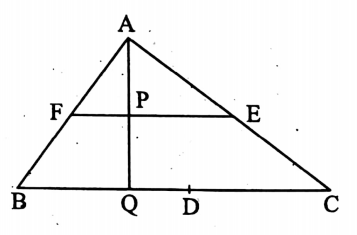
Question 2. A, B, C, and D are the mid-points of the sides PQ, QR, RS, and SP respectively of the parallelogram PQRS. The area of PQRS = 36 sq. cm. Then the area of the region ABCD is-
- 24 sq. cm
- 18 sq. cm
- 32 sq. cm
- 64 sq. cm
Solution:
Given
A, B, C, and D are the mid-points of the sides PQ, QR, RS, and SP respectively of the parallelogram PQRS.
The area of PQRS = 36 sq. cm.
Let us join B, D.
∴ BD || QP
Now, Δ ABD = ![]() PQB………………(1)
PQB………………(1)
[∵ both of them have the same base BD and between the same parallels DB and PQ.]
Again, ΔBCD = \(\frac{1}{2}\) ![]() BDSR……...(2) [For some reason]
BDSR……...(2) [For some reason]
∴ ΔABD+ Δ BCD = \(\frac{1}{2}\) ![]() PQBD +
PQBD + ![]() BDSR [from (1) and (2)]
BDSR [from (1) and (2)]
or, Region ABCD = \(\frac{1}{2}\) (![]() PQBD +
PQBD + ![]() BDSR)
BDSR)
or, Region ABCD = \(\frac{1}{2}\) ![]() PQRS [∵
PQRS [∵ ![]() PQBD +
PQBD + ![]() BDSR =
BDSR = ![]() PQRS]
PQRS]
= \(\frac{1}{2}\) 36 sq. cm
= 18 sq. cm.
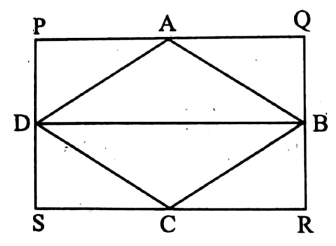
Question 3. O is any point inside the parallelogram ABCD. ΔAOB + ΔCOD = 16 sq. cm. Then the area of the parallelogram ABCD is—
- 8 sq. cm
- 4 sq. cm
- 32 sq. cm
- 64 sq. cm
Solution:
Given
O is any point inside the parallelogram ABCD.
ΔAOB + ΔCOD = 16 sq. cm.
Let us draw AB 11 EOF, which intersects AD at E and BC at F.
\(\frac{1}{2}\) ![]() ΔBFE = ΔAOB……………(1)
ΔBFE = ΔAOB……………(1)
[∵ base of both of them is AB and are between the same parallels AB and EF. ]
Again, \(\frac{1}{2}\) ![]() DEFC = ΔCOD …………..(2) [For same reason]
DEFC = ΔCOD …………..(2) [For same reason]
Now, adding (1) and (2) we get,
\(\frac{1}{2}\) ![]() ABFE + \(\frac{1}{2}\)
ABFE + \(\frac{1}{2}\) ![]() DEFC = Δ AOB + Δ COD.
DEFC = Δ AOB + Δ COD.
or, \(\frac{1}{2}\) ( ![]() ABFE +
ABFE + ![]() DEFC) = 16 sq. cm (Given)
DEFC) = 16 sq. cm (Given)
or, \(\frac{1}{2}\) ![]() ABCD = 16 sq. cm
ABCD = 16 sq. cm
or, ![]() ABCD = 16 x 2 sq. cm
ABCD = 16 x 2 sq. cm
or, ![]() ABCD = 32 sq. cm.
ABCD = 32 sq. cm.
∴ the area of the parallelogram ABCD = 32 sq. cm.
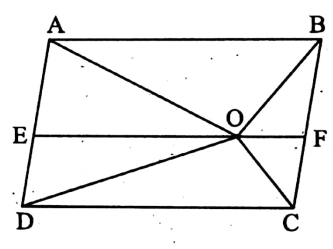
Question 4. D is the mid-point of BC of ΔABC. E and O are the mid-points of BD and AE respectively. Then the area of the triangle BOE is—
- \(\frac{1}{3}\) x area of ΔABC
- \(\frac{1}{4}\) x area of ΔABC
- \(\frac{1}{6}\) x area of ΔABC
- \(\frac{1}{8}\) x area of ΔABC
Solution:
Given
D is the mid-point of BC of ΔABC. E and O are the mid-points of BD and AE respectively.
We know, the median of a triangle bisects the triangle into two triangles of equal areas, [by cor.-5]
∴ Δ BOE = \(\frac{1}{2}\) Δ ABE (here BO is the median)
= \(\frac{1}{2}\) x \(\frac{1}{2}\) ΔABD (here AE is the median)
= \(\frac{1}{2}\) x \(\frac{1}{2}\) x \(\frac{1}{2}\) ΔABC (here AD is the median)
= \(\frac{1}{8}\) ΔABC.
∴ \(\frac{1}{8}\) x area of ΔABC is the correct.
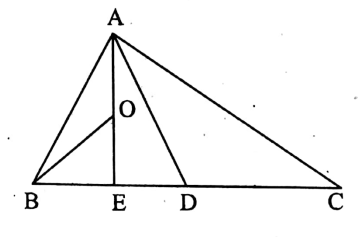
Question 5. A parallelogram, a rectangle, and a triangle are on the same base and between the same parallels and their areas are P, R, and T respectively, then
- P = R = 2T
- P = R = \(\frac{T}{2}\)
- 2P = 2R = T
- P = R = T
Solution:
Given
A parallelogram, a rectangle, and a triangle are on the same base and between the same parallels and their areas are P, R, and T respectively.
The areas of a parallelogram and of a rectangle having the same base and between the same parallels are equal.
∴ P = R (1)
The area of a parallelogram is twice the area of a triangle.
∴ P = 2T………………(2)
The area of a rectangle is twice the area of a triangle.
∴ R = 2T (3)
From (1), (2) and (3) we get, P = R = 2T.
∴ 1. P = R = 2T is correct.
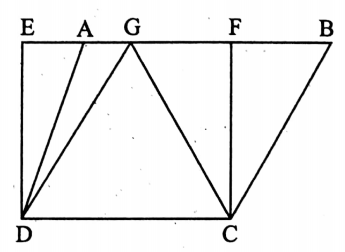
Question 6. PM is a median of the Δ PQR. PM is extended to N such that PM = MN. If O is the mid-point of MN and if the area of Δ PQR is 40 sq. cm, then the area of the ΔQOM is—
- 20 sq. cm
- 10 sq. cm
- 25 sq. cm
- 30 sq. cm
Solution:
Given
PM is a median of the Δ PQR. PM is extended to N such that PM = MN.
O is the mid-point of MN and if the area of Δ PQR is 40 sq. cm.
PM is the median of ΔPQR.
∴ ΔPQM = \(\frac{1}{2}\) Δ PQR = \(\frac{1}{2}\) x 40 sq. cm = 20 sq.cm
Again, QM is the median of Δ PQN.
∴ Δ QMN = Δ PQM = Δ PQM = 20 sq. cm
Now, QO is a median of the Δ QMN.
ΔQOM = \(\frac{1}{2}\) Δ QMN = \(\frac{1}{2}\) x 20 sq. cm = 10 sq. cm
the required area = 10 sq. cm.
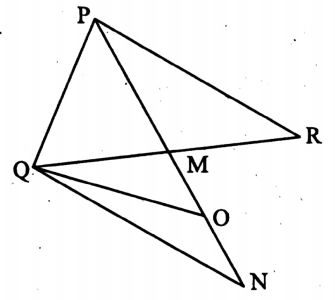
Chapter 3 Theorems On Areas Short Answer Type Questions
Question 1. DE is the perpendicular drawn from D of the parallelogram ABCD to its side AB and BF is the perpendicular drawn from B of ABCD to its side AD. If AB = 10 cm, AD = 3 cm and DE = 6 cm, then find BF.
Solution:
Given
DE is the perpendicular drawn from D of the parallelogram ABCD to its side AB and BF is the perpendicular drawn from B of ABCD to its side AD.
AB = 10 cm, AD = 3 cm and DE = 6 cm.
Let us join B, D.
Now, Δ ABD = \(\frac{1}{2}\) x AB x DE [ ∵ area of a triangle = \(\frac{1}{2}\) x base x height ]
= \(\frac{1}{2}\) x 10 x 6 sq. cm
= 30 sq. cm
Again, ΔABD = \(\frac{1}{2}\) x AD x BF
or, 30 sq. cm = \(\frac{1}{2}\) x 8 cm x BF
or, BF = \(\frac{30}{4}\) cm = 7.5 cm
∴ the required length = 7.5 cm
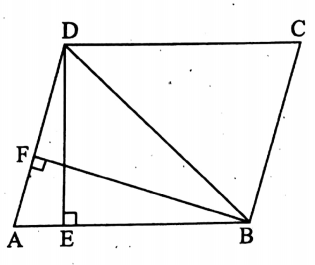
Question 2. The area of the parallelogram Δ BCD is 100 sq. units. P is the mid-point of BC. Determine the area of the Δ ABP.
Solution:
Given
The area of the parallelogram Δ BCD is 100 sq. units. P is the mid-point of BC.
Let us join A and C.
Then the diagonal AC bisects the parallelogram ABCD into two triangles of equal areas.
ΔABC = \(\frac{1}{2}\) ![]() ABCD = \(\frac{1}{2}\) x 100 sq. units = 50 sq. units
ABCD = \(\frac{1}{2}\) x 100 sq. units = 50 sq. units
Again, AP is a median of ΔABC.
ΔABP = \(\frac{1}{2}\) ΔABC = \(\frac{1}{2}\) x 50 sq. units
= 25 sq. units
∴ the required area = 25 sq.units
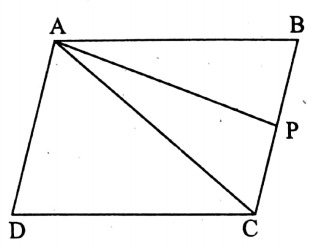
Question 3. AD is a median of ΔABC and P is a point on the side AC of ΔABC such that area of ΔADP: area of ΔABD = 2 : 3; Determine the ratio (area of ΔPDC: area of ΔABC).
Solution:
Given
AD is a median of ΔABC and P is a point on the side AC of ΔABC such that area of ΔADP: area of ΔABD = 2 : 3
AD is a median of ΔABC
area of ΔABD = area of ΔACD
Now, the area of ΔADP: area of AABD = 2 : 3 (Given)
area of ΔADP : area of ΔACD = 2 : 3 [ ∵ AABD = AACD]
or, \(\frac{\text { area of } \triangle \mathrm{ADP}}{\text { area of } \triangle \mathrm{ACD}}=\frac{2}{3}\)
or, \(\frac{\text { area of } \triangle \mathrm{ADC}-\text { area of } \triangle \mathrm{PDC}}{\text { area of } \triangle \mathrm{ACD}}=\frac{2}{3}\)
or 3 (area of ΔACD) – 3 (area of APDC) = 2 (area of ΔACD)
or, 3 (area of ΔPDC) = area of ΔACD = \(\frac{1}{2}\) (area of ΔABC) [∵ ΔACD = \(\frac{1}{2}\) ΔABC]
or, \(\frac{\text { area of } \triangle \mathrm{PDC}}{\text { area of } \triangle \mathrm{ABC}}=\frac{1}{6}\)
∴ area of ΔPDC: area of ΔABC = 1:6.
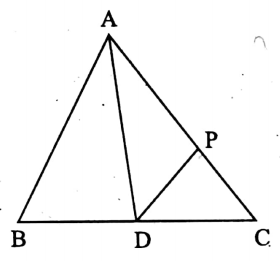
Alternative Method:
∵ ΔADP: ΔABD = 2:3.
Let ΔADP = 2a sq. units and ΔABD = 3a sq. units,
∵ AD is a median of ΔABC,
∴ ΔABD = ΔACD.
Now, ΔACD = ΔABD or, ΔADP +ΔPDC = ΔABD
or, 2a + ΔPDC = 3a
or, ΔPDC = a………….(1)
Again, ΔABC = 2ΔABD = 2 x 3a = 6a………………(2)
∴ \(\frac{\Delta \mathrm{PDC}}{\Delta \mathrm{ABC}}=\frac{a}{6 a}\) [from (1) and (2)]
or, \(\frac{\Delta \mathrm{PDC}}{\Delta \mathrm{ABC}}=\frac{1}{6}\)
∴ ΔPCD: ΔABC = 1:6
The ratio (area of ΔPDC: area of ΔABC) = 1:6
Question 4. ABDE is a parallelogram. F is the mid-point of ED. If the area of the triangle ABD is 20 sq. cm, find the area of AAEF.
Solution:
Given
ABDE is a parallelogram. F is the mid-point of ED. If the area of the triangle ABD is 20 sq. cm.
F is the mid-point of ED.
∴ AF is a median of ΔADE.
∴ΔAEF = \(\frac{1}{2}\) ΔAED \(\frac{1}{2}\) ΔABD [∵ ΔAED = ΔABD]
= \(\frac{1}{2}\) x 20 sq. cm
= 10 sq. cm. area of ΔAEF
= 10 sq. cm
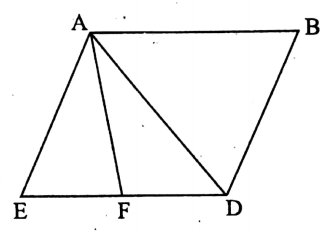
The area of AAEF = 10 sq. cm
Question 5. PQRS is a parallelogram. X and Y are the mid-points of PQ and SR respectively of PQRS. The diagonal SQ is joined. Then determine, (area of ![]() XQRY: area of AQSR).
XQRY: area of AQSR).
Solution:
Given
PQRS is a parallelogram. X and Y are the mid-points of PQ and SR respectively of PQRS. The diagonal SQ is joined.
X and Y are the mid-points of PQ and SR.
∴ height of the ![]() XQRY is half of the height of
XQRY is half of the height of ![]() the PQRS when QR is the base of both of them.
the PQRS when QR is the base of both of them.
∴ ![]() XQRY = \(\frac{1}{2}\) PQRS………..(1)
XQRY = \(\frac{1}{2}\) PQRS………..(1)
Again, diagonal QS bisects the PQRS parallelogram into two triangles of equal areas.
∴ ΔQSR = \(\frac{1}{2}\) ![]() PQR…..(2)
PQR…..(2)
From (1) and (2) we get, ![]() XQRY = Δ SQR.
XQRY = Δ SQR.
or, ![]() \(\frac{\mathrm{XQRY}}{\Delta \mathrm{SQR}}=\frac{1}{1}\)
\(\frac{\mathrm{XQRY}}{\Delta \mathrm{SQR}}=\frac{1}{1}\)
or, ![]() XQRY: ΔSQR = 1: 1.
XQRY: ΔSQR = 1: 1.
∴ the required ratio=1:1.
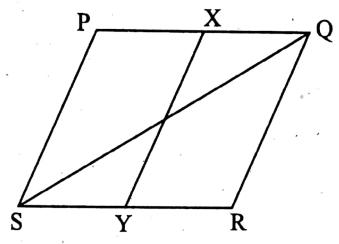
Question 6. E is the mid-point of the median AD of the ΔABC. Prove that Δ BED = \(\frac{1}{4}\) ΔABC.
Proof:
Given
E is the mid-point of the median AD of the ΔABC.
AD is the mid-point of ΔABC,
∴ ΔABD = \(\frac{1}{2}\) ΔABC………...(1)
[∵ median of any triangle bisects it into two triangles of equal areas. ]
Again, E is the mid-point of AD.
∵ BE is a median of ΔABD.
∵ ΔBED = \(\frac{1}{2}\) ΔABD = \(\frac{1}{2}\) x ΔABC [by (1)]
= \(\frac{1}{4}\)ΔABC.
ΔBED = \(\frac{1}{4}\)ΔABC (Proved)
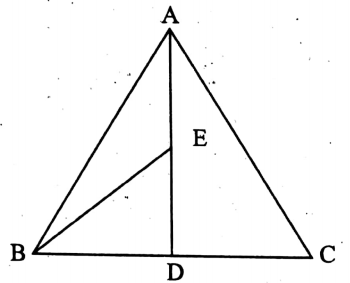
Chapter 3 Theorems On Areas Long Answer Type Questions
Question 1. P and Q are the mid-points of the sides AB and DC of the parallelogram ABCD. Prove that the area of the quadrilateral APCQ = 1/2 x area of the parallelogram ABCD.
Given: P and Q are the mid-points of the sides AB and DC of the parallelogram ABCD.
Let us join P, C and A, Q.
To prove: ![]() APCQ = 1/2
APCQ = 1/2 ![]() ABCD.
ABCD.
Construction: Let us draw the diagonal AC.
Proof: Pis the mid-point of AB,
∴ CP is a median of Δ ABC.
ΔAPC = 1/2 ΔABC..…………………(1)
Again, Q is the mid-point of DC.
∴ AQ is a median of ΔACD.
ΔACQ = 1/2 Δ ACD……….(2)
From (1) and (2) we get, ΔAPC + Δ ACQ + \(\frac{1}{2}\) Δ ABC + \(\frac{1}{2}\) ΔACD.
or, ![]() APCQ = \(\frac{1}{2}\)(Δ ABC + Δ ACD) = \(\frac{1}{2}\)
APCQ = \(\frac{1}{2}\)(Δ ABC + Δ ACD) = \(\frac{1}{2}\)![]() ABCD.
ABCD.
∴ ![]() APCQ =
APCQ = ![]() ABCD. (Proved)
ABCD. (Proved)
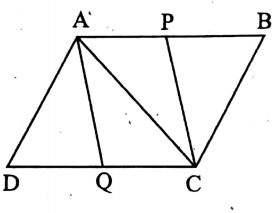
Question 2. The distance between the sides AB and DC of the rhombus ABCD is PQ and that between AD and BC is RS. Prove that PQ = RS.
Given: The distance between the sides AB and DC of the rhombus ABCD is PQ and that between AD and BC is RS.
To prove: PQRS
Construction: Let P be any point on AB and let us draw PQ ⊥ DC.
Also, let R be any point on AD, and let us draw RS ⊥ BC.
Proof: PQ ⊥ DC,
∴ PQ is the height of the rhombus ABCD (w. r. t. base DC)
∴ area of ![]() ABCD = DC X PQ…..(1) [ area of the parallelogram base x height]
ABCD = DC X PQ…..(1) [ area of the parallelogram base x height]
Again, RS ⊥ BC,
∴ RS is the height of ABCD (w. r. t. BC)
∴ area of ![]() ABCD = BC x RS = DC x RS……………….(2) [ ∵ AB=BC= CD = DA.]
ABCD = BC x RS = DC x RS……………….(2) [ ∵ AB=BC= CD = DA.]
Now, from (1) and (2) we get, DC x PQ = DC x RS.
or, PQ = RS.
∴ PQ = RS. (Proved)
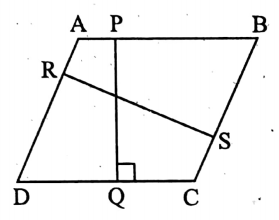
Question 3. In the isosceles ΔABC, AB = AC, and P be any point on the extended BC. PQ and PR are the perpendiculars on the sides AB and AC respectively. BS is the perpendicular drawn from B to AC. Prove that PQ-PR = BS.
Given: In the isosceles ΔABC, AB = AC, and P is any point on the extended BC.
PQ and PR are the perpendiculars drawn from P to AB and AC respectively and BS is the perpendicular drawn from B to AC.
To prove PQ-PR = BS.
Construction: Let us join A, P.
Proof: In ΔABP, PQ ⊥ AB.
∴ \(\Delta \mathrm{ABP}=\frac{1}{2} \times \mathrm{AB} \times \mathrm{PQ}\)………..(1)
In \(\triangle \mathrm{A} P C, P R \perp\) (extended AC)
∴ w. r. t. the base AC, the height of ΔAPC is PR.
∴ \(\Delta \mathrm{APC}=\frac{1}{2} \times \mathrm{AC} \times \mathrm{PR}\) ……..(2)
Again, in \(\triangle \mathrm{ABC}, \mathrm{BS} \perp \mathrm{AC}\)
∴ \(\Delta \mathrm{ABC}=\frac{\mathrm{I}}{2} \times \mathrm{AC} \times \mathrm{BS}\)………..(3)
Now, according to the Δ ABP – Δ APC = Δ ABC.
or, \(\frac{1}{2} \times \mathrm{AB} \times \mathrm{PQ}-\frac{1}{2} \times \mathrm{AC} \times \mathrm{PR}=\frac{1}{2} \times \mathrm{AC} \times \mathrm{BS}\)
or, \(\frac{1}{2} \times \mathrm{AC} \times \mathrm{PQ}-\frac{1}{2} \times \mathrm{AC} \times \mathrm{PR}=\frac{1}{2} \times \mathrm{AC} \times \mathrm{BS}\)
[ AB = AC ]
Or, \(\frac{1}{2} \times \mathrm{AC}(\mathrm{PQ}-\mathrm{PR})=\frac{1}{2} \times \mathrm{AC} \times \mathrm{BS}\)
or, \(P Q-P R=B S \text {. [eliminating } \frac{1}{2} \times \mathrm{AC} \text { from both the sides] }\)
∴ PQ-PR = BS: (Proved)
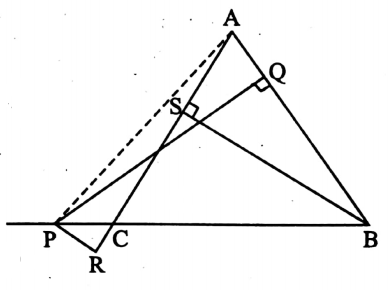
Question 4. A straight line, parallel to the side AB of the parallelogram ABCD intersects AD, AC, and BC or their extended parts at points E, F, and G respectively. Prove that Δ AEG = Δ AFD.
Given: The straight line PQ, parallel to the side AB of the parallelogram ABCD intersects AD, AC, and BC at the points E, F, and G respectively.
Let us join A, G, and F, D.
To prove: Δ AEG = Δ AFD.
Proof: AB || EG and AE || BG,
∴ ABGE is a parallelogram, the diagonal of which is AG.
∴ \(\Delta \mathrm{AEG}=\frac{1}{2}\) ![]() ABGE ………(1)
ABGE ………(1)
[ the diagonal of a parallelogram bisects it into two triangles of equal areas ]
Again, EG || DC and ED || GC,
∴ EGCD is a parallelogram.
∴ \(\Delta \mathrm{CDF}=\frac{1}{2}\) ![]() EGCD…………….(2) [these are on the same base DC and between the same parallels DC and EG]
EGCD…………….(2) [these are on the same base DC and between the same parallels DC and EG]
Now, Δ AFD = Δ ACD – ΔCDF = \(\)
[ diagonal AC bisects ![]() ABCD into two triangles of equal areas and by (2)]
ABCD into two triangles of equal areas and by (2)]
= \(\frac{1}{2}\) ![]() ABCD – \(\frac{1}{2}\) (
ABCD – \(\frac{1}{2}\) (![]() ABCD –
ABCD – ![]() ABGE)
ABGE)
= \(\frac{1}{2}\) ![]() ABGE
ABGE
= ΔAEG[by (1)]
Δ AEG = Δ AFD. (Proved)
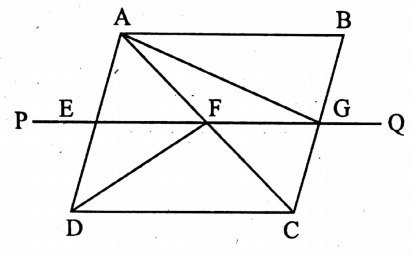
Question 5. Two triangles ABC and ABD of equal areas are on the opposite sides of AB. Prove that AB bisects CD equally.
Given: ΔABC and ΔABD are of equal areas and are on the opposite sides of AB, let us join C, and D.
To prove AB bisects CD equally.
Proof: ΔABC = ΔABD (Given)
∴ diagonal AB bisects the quadrilateral into two triangles of equal areas.
∴ the quadrilateral is a parallelogram.
Again CD is also a diagonal of the parallelogram ACBD and we know that the two diagonals of a parallelogram bisects each other.
∴ AB bisects CD equally. (Proved)
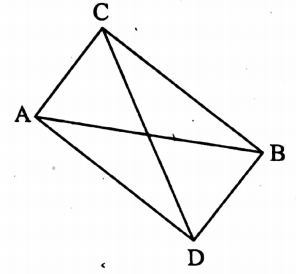
Alternative Method:
Given: ΔABC and ΔABD are of equal areas and are on the opposite sides of AB, let us join C, D. To prove AB bisects CD equally.
To prove: ΔABC= ΔABD (Given)
Construction: Let us draw CE LAB and DF ⊥ AB.
Let AB intersects with CD at O.
Proof: AB and CE are the base and height of the ΔABC respectively.
∴ ΔABC = \(\frac{1}{2}\) x AB X CE ………(1)
AB and DF are the base and height of Δ ABD.
∴ ΔABD = \(\frac{1}{2}\) x AB x Df……..(2)
Given that ΔABC = ΔABD
or, \(\frac{1}{2}\) x AB x CE = \(\frac{1}{2}\) x AB x DF [by (1) and (2)]
or, CE = DF…………(3)
Now, in triangles, ΔCOE and ΔDOF, ∠CEO = ∠DFO[each is right-angle]
<COE = 2DOF [∵ opposite angles ] and CE = DF [by (3)]
∴ ΔCOE ≅ Δ DOF [by the condition of A-A-S congruence]
∴ CO = DO [ similar sides of two congruent triangles]
∴ AB bisects CD equally. (Proved)
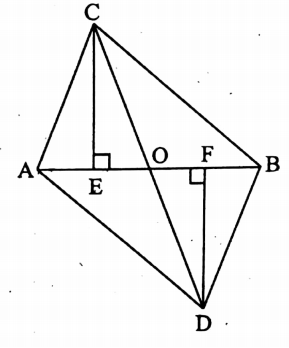
Question 6. D is the mid-point of the side BC of the ΔABC. The parallelogram CDEF lies between the same parallels BC and PQ, a parallel st. line of BC through A. Prove that A ABC = ![]() CDEF
CDEF
Given: D is the mid-point of BC.
The parallelogram CDEF between the same parallels BC and PQ, a parallel st. line of BC through A.
To prove ΔABC = ![]() CDEF.
CDEF.
Construction: Let us draw AL ⊥ BC.
Proof: The height of the A ABC is AL w.r.t. the base BC.
∴ ΔABC = \(\frac{1}{2}\) BC x AL………………....(1)
Also, the height of the parallelogram CDEF is AL.
∴ ![]() CDEF = CD x AL [ area of a parallelogram = base x height]
CDEF = CD x AL [ area of a parallelogram = base x height]
\(\frac{1}{2}\) BC x AL [∵ D is the mid-point of BC]
= Δ ABC. [by (1)]
Δ ABC= ![]() CDEF. (Proved)
CDEF. (Proved)
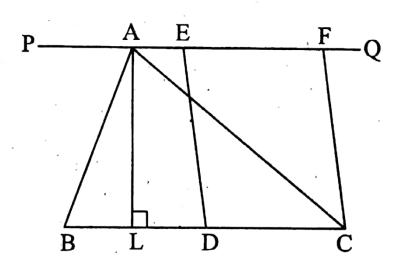
Alternative Method:
Given: D is the mid-point of BC.
The parallelogram CDEF between the same parallels BC and PQ, a parallel st. line of BC through A.
To prove Δ ABC = ![]() CDEF.
CDEF.
Construction: Let us join A, D.
Proof: AD is a median of ΔABC,
∴ \(\Delta \mathrm{ADC}=\frac{1}{2} \Delta \mathrm{ABC}\) ………..(1)
[∵ median of any triangle bisects it into two triangles of equal areas. ]
Again, ΔADC and![]() CDEF are on the same base and between the same parallels BC and PQ,
CDEF are on the same base and between the same parallels BC and PQ,
∴ Δ ADC = \(\frac{1}{2}\) CDEF…………..(2)
From (1) and (2) we get, \(\frac{1}{2}\) Δ ABC = \(\frac{1}{2}\) ![]() =CDEF.
=CDEF.
or, ΔABC = ![]() CDEF (Proved)
CDEF (Proved)
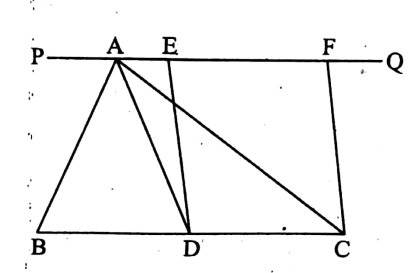
Question 7. P is any point on the diagonal BD of the parallelogram ABCD. Prove that Δ APD = Δ CPD.
Given: P is any point on the diagonal BD of the parallelogram ABCD.
To prove ΔAPD = Δ CPD.
Construction: Let us draw the diagonal AC. Let the diagonals AC and BD intersect each other at O.
Proof: ∴ AO = CO[ the diagonals of a parallelogram bisect each other]
∴ O is the mid-point of AC.
Now, DO is a median of ACD,
∴ Δ AOD = Δ COD………..(1)
[the median of a triangle bisects it into two triangles of equal areas. ]
Again, PQ is a median of ΔACP,
∴ Δ AOP = Δ COP……..(2) [ for similar reason ]
Thus, subtracting (2) from (1) we get, Δ AOD – Δ AOPA = ΔCOD – Δ COP
or, Δ APD = Δ CPD
∴ Δ APD = ΔCPD. (Proved)
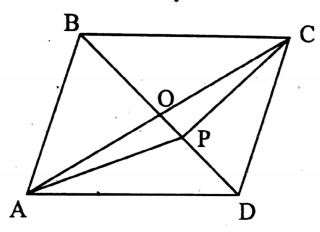
Question 8. AD and BE are the medians of the triangle ABC. Prove that Δ ACD = Δ BCE. Given: AD and BE are the medians of ▲ ABC.
To prove: Δ ACD = Δ BCE
Proof: AD is a median of Δ ABC,
∴ Δ ACD = \(\frac{1}{1}\)
[median of a triangle divides it into two triangles of equal areas. ]
Again, BE is a median of ΔABC,
Δ BCE = \(\frac{1}{2}[/laetx] Δ ABC…………..(2) [for similar reason]
Now, from (1) and (2) we get, Δ ACD = ΔBCE.
∴ Δ ACD = Δ BCE. (Proved)
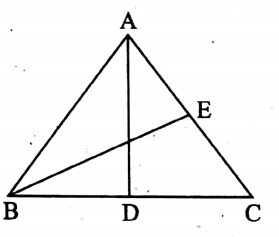
Question 9. The straight line parallel to BC intersects AB and AC at P and Q respectively. CP and BQ intersect each other at X. Prove that,
1. Δ BPQ = Δ CPQ
2. Δ BCP = Δ BCQ
3. Δ ACP = Δ ABQ
4. Δ BXP = Δ CXQ
Given: The straight line PQ, Parallel to BC intersects AB and AC at P and Q respectively.
CP and BQ intersect each other at X.
To prove:
1. Δ BPQ = Δ CPQ
2. Δ BCP = Δ BCQ
3. Δ ACP = Δ ABQ
4. Δ BXP = Δ CXQ
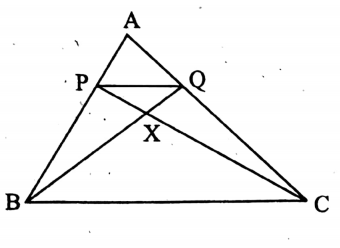
Proof:
1. ΔBPQ and Δ CPQ have the same base PQ and are
between the same parallels PQ and BC.
∴ ΔBCP = Δ BCQ. (Proved) [ by theorem-3]
2. Δ BCP and Δ BCQ have the same base BC and are between the same parallels BC and PQ.
∴ Δ BCP = Δ BCQ. (Proved) [by the theorem-3]
3. From (1) we get, Δ BPQ = Δ CPQ
or, ΔBPQ + Δ APQ = Δ CPQ+Δ APQ [ adding Δ APQ]
or, Δ ABQ=Δ ACP
∴ ΔACP = Δ ABQ. (Proved)
4. From (2) we get, Δ BCP =Δ BCQ
or, Δ BCP – Δ BXC = Δ BCQ-Δ BXC. [ subtracting ΔBXC]
or, Δ BXP = Δ CXQ
∴ Δ BXP = Δ CXQ. (Proved)
Question 10. In ΔABC, AB = AC. The perpendiculars drawn from B and C to AC and AB respectively, intersect the sides AC and AB at the points E and F respectively. Prove that FE || BC.
Given: In ΔABC, AB = AC.
The perpendiculars drawn from B and C to AC and AB respectively, intersect the sides AC and AB at the points E and F respectively.
To prove FE || BC.
Proof: In Δ ABC, AB = AC, ∠ABC = ∠ACB [ the angles opposite to the equal sides are equal.]
Now, in ΔBCF and Δ BCE,∠BFC = BEC ( each is right-angles),
∠FBC= ∠BCE (∠ABC = ∠ACB) and BC are common to both.
ΔBCF ≅ Δ BCE [by the condition of A-A-S congruence]
∴ Δ BCF = ΔBCE.
But they are on the same base BC and between the same parallels BC and EF.
∴ the line segments must be parallel [ by theorem-4]
∴ FE || BC. (Proved)
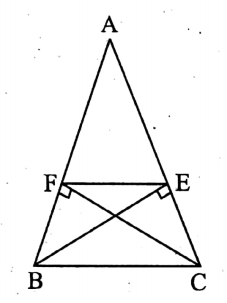
Question 11. In triangle ABC, ∠ABC = ∠ACB. The bisectors of ∠ABC and ∠ACB intersect AC and AB at E and F respectively. Prove that FE || BC.
Given: In Δ ABC, ABC = ACB.
The bisectors of ABC and ACB intersect AC and AB at E and F respectively.
Let us join E and F.
To prove FE || BC.
Proof: <ABC = ∠ACB (Given)
or, [latex]\frac{1}{2}\) ∠ABC= \(\frac{1}{2}\) ∠ACB.
or, ∠EBC = ∠FCB……………….(1)
[ BE is the bisector of ∠ABC and CF is the bisector of ∠ACB ]
Now, in Δ BCF and Δ BCE, ∠FCB = ∠EBC [by (1)]
∠FBC= ∠ECB [∠ABC= ∠ACB] and BC are common to both.
∴ Δ BCF ≅ Δ BCE.
∴ Δ BCF = Δ BCE.
But these triangles have the same base BC and are between the line segments BC and FE.
∴ the line segments must be parallel, [by theorem-4].
∴ FE || BC. (Proved)
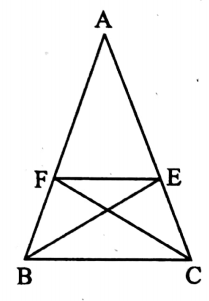
Question 12. ∠A is common to both the parallelograms ABCD and AEFG having equal areas and E lies on the side AB. Prove that DE FC.
Given: ∠A is common to both the ABCD and AEFG and E lies on the side AB. Let us join D, E and F, C.
To prove DE || FC.
Construction: Let us join E, E, and F, C. Let us join D, F, and E, C.
Proof: A DEF and ![]() AEFG are on the same base EF and between the same parallels EF and AG.
AEFG are on the same base EF and between the same parallels EF and AG.
∴ ΔDEF = \(\frac{1}{2}\) ![]() ΔEFG………………..(1) [ by theorem-2]
ΔEFG………………..(1) [ by theorem-2]
Again, ΔCDE and ![]() ABCD are on the same base DC and between the same parallels DC and AB.
ABCD are on the same base DC and between the same parallels DC and AB.
∴ ΔCDE = \(\frac{1}{2}\) ABCD [by theorem-2]
or, ΔCDE………………(2) [ Given that ![]() ABCD=
ABCD= ![]() AEFG]
AEFG]
From (1) and (2) we get, ADEF = ACDE.
But they are on the same side of the same base DE and between two line segments DE and FC.
∴ the line segments must be parallel.
∴ DE || FC. (Proved)
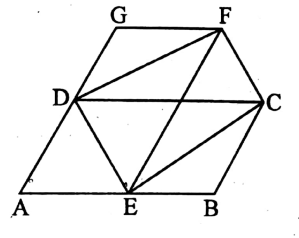
Question 13. ABCD is a parallelogram and ABCE is a quadrilateral. The diagonal AC divides ABCE into two triangles of equal areas. Prove that AC || DE.
Given: ABCD is a parallelogram and ABCE is a quadrilateral.
The diagonal AC divides ABCE into two triangles of equal areas. Let D and E be joined.
To prove AC || DE.
Proof: Given that ΔABC = Δ AEC…………....(1)
Again, AC is a diagonal of ![]() ABCD
ABCD
∴ Δ ABC = Δ ADC………(2)
Thus, from (1) and (2) we get, Δ AEC = Δ ADC.
[diagonal of a parallelogram divides it into two triangles of equal areas..]
But they are on the same side of the same base AC and between two line segments AC and DE.
the two line segments must be parallel [ by theorem-4].
∴ AC || DE. (Proved)
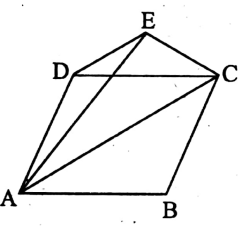
Question 14. D is the mid-point of BC of ΔABC. P and Q are on the sides BC and BA such that ABPQ= \(\frac{1}{2}\)ΔABC, proving that DQ || PA.
Given: D is the mid-point of the side BC of ΔABC.
P and Q lie on the sides BC and BA such that ΔBPQ= \(\frac{1}{2}\) ΔABC.
Let us join D, Q, and P, A.
To prove DQ || PA.
Construction: Let us join A, D.
Proof: Given that D is the mid-point of BC.
∴ AD is a median of Δ ABC.
∴ ΔABD = \(\frac{1}{2}\) ΔABC……….(1)
[median of a triangle bisects it equally.]
Again, ΔBPQ = \(\frac{1}{2}\) ΔАВС……....(2) (Given)
Thus, from (1) and (2) we get, Δ ABD = Δ BPQ
or, ΔABD – ΔBDQ = Δ BPQ-Δ BDQ
or, Δ QAD = Δ DPQ
But they are on the same side of the same base DQ and between two line segments DQ and PA.
∴ the two line segments must be parallel. [ by theorem-4].
∴ DQ || PA. (Proved)
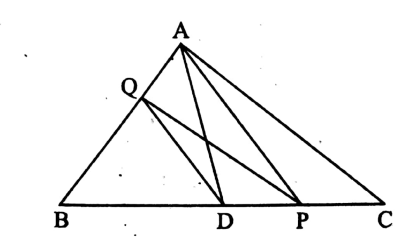
Question 15. In the trapezium AB || DC and E is the mid-point of BC. Prove that ΔAED = \(\frac{1}{2}\) ![]() ABCD.
ABCD.
Given: In the ABCD, AB || DC and E are the mid-point of BC.
To prove : AAED = \(\frac{1}{2}\) x ![]() ABCD.
ABCD.
Construction: Let us draw the diagonals AC and BD.
Proof: E is the mid-point of BC (Given),
∴ AE is a median of ΔABC.
∴ ΔABE = \(\frac{1}{2}\) ΔABC……………(1)
[median of a triangle divides it into two triangles of equal areas. ]
Again, DE is the median of ABCD,
∴ ΔCDE = \(\frac{1}{2}\) Δ BCD …………….(2) [for some reason]
Now, ABCD and ΔACD are on the same base DC and between the same parallels DC and AB.
∴ ΔBCD = ΔACD………….(3) [by theorem-3]
∴ From (2) and (3) we get, ACDE = \(\frac{1}{2}\) ΓACD……..(4)
Now, adding (1) and (4) we get, ΔABE + ΔACDE = \(\frac{1}{2}\) ΔABC + \(\frac{1}{2}\) ΔACD.
or, ![]() ABCD – ΔAED = \(\frac{1}{2}\) (ΔABC + ΔACD)
ABCD – ΔAED = \(\frac{1}{2}\) (ΔABC + ΔACD)
or, ![]() ABCD – \(\frac{1}{2}\) x
ABCD – \(\frac{1}{2}\) x ![]() ΔBCD = ΔAED
ΔBCD = ΔAED
Or, \(\frac{1}{2}\) ![]() ABCD = ΔAED
ABCD = ΔAED
∴ ΔAED = \(\frac{1}{2}\) x (area of trapezium ABCD). (Proved)
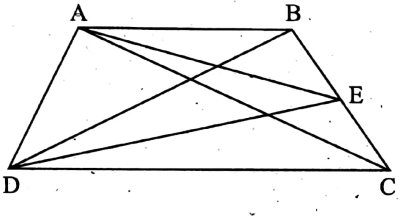
Question 16. E is any point on the side DC of the parallelogram ABCD. Extended AE intersects extended BC at F. Let us join D and F. Prove that AADF = AABE.
Given: E is any point on the side DC of the parallelogram ABCD.
Extended AE intersects extended BC at F.
Let us join D and F.
To prove AADF = AABE
Construction: Let us join B and E.
Proof: ΔADF and ![]() ABCD are on the same base AD and between the same parallels AD and BF.
ABCD are on the same base AD and between the same parallels AD and BF.
∴ ΔADF = ΔBCD ……………(1) [by theorem – 2]
Again, Δ ABE and ![]() ABCD are on the same base AB and between the same parallels AB and DC.
ABCD are on the same base AB and between the same parallels AB and DC.
∴ ΔABE = \(\frac{1}{2}\) ![]() ABCD……..(2) [by theorem-2]
ABCD……..(2) [by theorem-2]
Now, from (1) and (2) we get, ΔADF = ΔABE
∴ ΔADF = ΔABE. (Proved)

